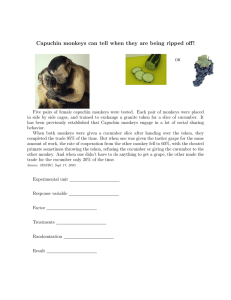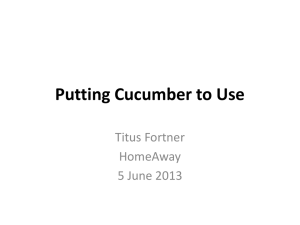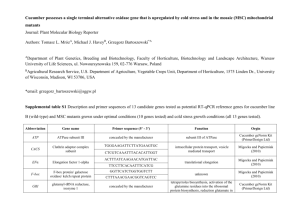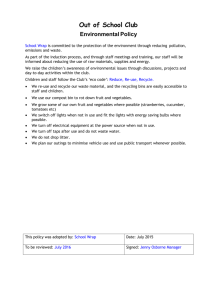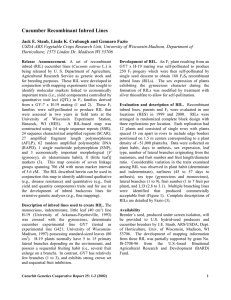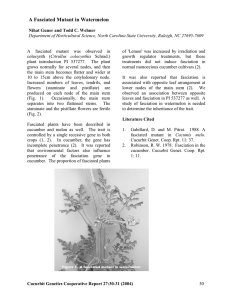2008 Public Sector Cucumber Research Priority Survey Yiqun Weng
advertisement
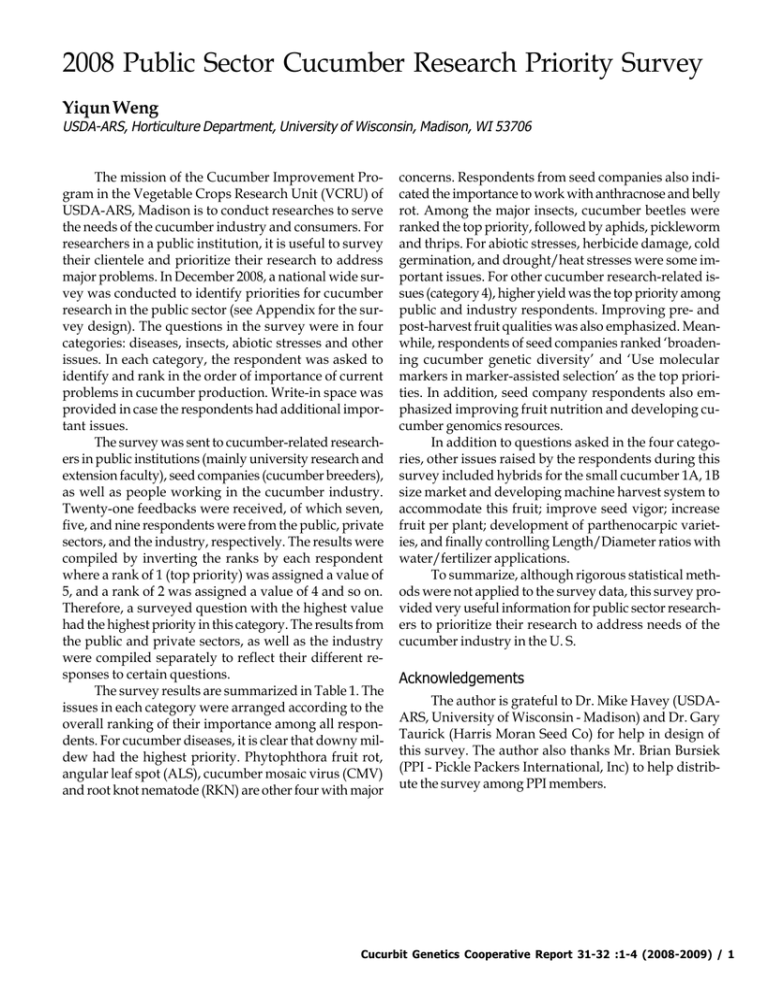
2008 Public Sector Cucumber Research Priority Survey Yiqun Weng USDA-ARS, Horticulture Department, University of Wisconsin, Madison, WI 53706 The mission of the Cucumber Improvement Program in the Vegetable Crops Research Unit (VCRU) of USDA-ARS, Madison is to conduct researches to serve the needs of the cucumber industry and consumers. For researchers in a public institution, it is useful to survey their clientele and prioritize their research to address major problems. In December 2008, a national wide survey was conducted to identify priorities for cucumber research in the public sector (see Appendix for the survey design). The questions in the survey were in four categories: diseases, insects, abiotic stresses and other issues. In each category, the respondent was asked to identify and rank in the order of importance of current problems in cucumber production. Write-in space was provided in case the respondents had additional important issues. The survey was sent to cucumber-related researchers in public institutions (mainly university research and extension faculty), seed companies (cucumber breeders), as well as people working in the cucumber industry. Twenty-one feedbacks were received, of which seven, five, and nine respondents were from the public, private sectors, and the industry, respectively. The results were compiled by inverting the ranks by each respondent where a rank of 1 (top priority) was assigned a value of 5, and a rank of 2 was assigned a value of 4 and so on. Therefore, a surveyed question with the highest value had the highest priority in this category. The results from the public and private sectors, as well as the industry were compiled separately to reflect their different responses to certain questions. The survey results are summarized in Table 1. The issues in each category were arranged according to the overall ranking of their importance among all respondents. For cucumber diseases, it is clear that downy mildew had the highest priority. Phytophthora fruit rot, angular leaf spot (ALS), cucumber mosaic virus (CMV) and root knot nematode (RKN) are other four with major concerns. Respondents from seed companies also indicated the importance to work with anthracnose and belly rot. Among the major insects, cucumber beetles were ranked the top priority, followed by aphids, pickleworm and thrips. For abiotic stresses, herbicide damage, cold germination, and drought/heat stresses were some important issues. For other cucumber research-related issues (category 4), higher yield was the top priority among public and industry respondents. Improving pre- and post-harvest fruit qualities was also emphasized. Meanwhile, respondents of seed companies ranked ‘broadening cucumber genetic diversity’ and ‘Use molecular markers in marker-assisted selection’ as the top priorities. In addition, seed company respondents also emphasized improving fruit nutrition and developing cucumber genomics resources. In addition to questions asked in the four categories, other issues raised by the respondents during this survey included hybrids for the small cucumber 1A, 1B size market and developing machine harvest system to accommodate this fruit; improve seed vigor; increase fruit per plant; development of parthenocarpic varieties, and finally controlling Length/Diameter ratios with water/fertilizer applications. To summarize, although rigorous statistical methods were not applied to the survey data, this survey provided very useful information for public sector researchers to prioritize their research to address needs of the cucumber industry in the U. S. Acknowledgements The author is grateful to Dr. Mike Havey (USDAARS, University of Wisconsin - Madison) and Dr. Gary Taurick (Harris Moran Seed Co) for help in design of this survey. The author also thanks Mr. Brian Bursiek (PPI - Pickle Packers International, Inc) to help distribute the survey among PPI members. Cucurbit Genetics Cooperative Report 31-32 :1-4 (2008-2009) / 1 Table 1. Results of Public Sector Research Priority Survey Categories 1. Diseases Downy mildew (DM) Phytophthora fruit rot Angular leaf spot (ALS) Cucumber mosaic virus (CMV) Root knot nematode (RKN) Bacterial wilt (BW) Powdery mildew (PM) Anthracnose Belly rot Gummy stem blight (GSB) Watermelon mosaic virus (WMV) Zucchini yellow mosaic virus (ZYMV) Cucurbit Yellow Stunting Disorder Virus Fusarium wilt (FW) Watermelon strain of papaya ringspot virus Scab 2. Insect pests Cucumber beetles Aphids Pickleworm Thrips Whiteflies Spider mites Leaf miners Others. 3. Abiotic stresses Herbicide damage Drought stress Cold germination Heat damage Chilling damage Saline stress (salt tolerance) 4. Other issues Higher fruit yield Improve pre-harvest fruit quality Broaden cucumber genetic diversity Use of molecular marker-assisted selection Improve post-harvest fruit quality Improved fruit nutrition Develop cucumber genomic resources Develop GMOs Industry Weights Rank 39 23 18 9 6 6 9 13 15 8 3 1 2 6 2 3 1 2 3 4 5 Private Weights Rank 20 13 11 8 14 1 2 0 0 3 4 5 6 3 0 0 1 3 4 5 2 Public Weights Rank 33 21 6 9 4 11 5 2 0 2 4 5 3 1 3 0 1 2 5 4 3 All Weights Rank 92 57 35 26 24 18 16 15 15 13 11 11 11 10 5 3 1 2 3 4 5 6 7 8 9 10 11 12 13 14 15 16 25 24 22 18 20 6 5 5 1 2 3 5 4 23 13 13 11 11 3 0 1 2 2 3 3 4 29 16 10 10 7 5 5 1 2 3 3 4 5 5 77 53 45 39 38 14 10 5 1 2 3 4 5 6 7 8 26 21 14 25 7 2 1 3 4 2 5 17 17 7 7 13 11 1 1 4 4 2 3 20 17 24 4 14 1 2 4 1 5 3 63 55 45 36 34 14 1 2 3 4 5 6 32 24 12 12 15 7 4 9 1 2 4 4 3 14 3 22 22 0 11 9 0 2 5 1 1 16 16 7 5 14 7 11 8 1 1 5 62 43 41 39 29 25 24 17 1 2 3 4 5 6 7 8 5 2 / Cucurbit Genetics Cooperative Report 31-32:1-4 (2008-2009) 3 4 2 5 3 4 Appendix 2008 Cucumber Research Priority Survey 1. I am a ________ Grower ________ Broker/Marketer ________ Green shipper ________ Private researcher ________ ________ ________ ________ Processor Salter Public researcher Others. Please specify _______ 2. My work focuses primarily on _________ Fresh market cucumber _________ Both _________ Processing cucumber 3. If Grower, please check: ________ Less than 100 acres________ 100 to 500 acres________ > 500 acres 4. Areas where you operate (check all that apply): ________ ________ ________ ________ ________ ________ Southeast (AL, AR, FL, GA, LA, KY, MS, NC, SC, TN, VA, WV) Northeast (CT, DE, MA, MD, ME, NH, NJ, NY, PA, RI, VT) Southwest (AZ, NM, OK, TX) Midwest (IA, IL, IN, KS, MI, MN, MO, ND, NE, OH, SD, WI) West (AK, CA, CO, HI, ID, MT, NV, OR, UT, WA, WY) International. Please specify ___________________________ For questions 5 to 8, please rank the top 5 topics that you think should be addressed by public-sector research (1 to 5 with 1 = top priority and 5 being lower priority). 5. Diseases __________ __________ __________ __________ __________ __________ __________ __________ __________ __________ __________ __________ __________ __________ __________ __________ __________ __________ Anthracnose (Colletotrichum orbiculare) Downy mildew (DM) (Pseudoperonospora cubensis) Fusarium wilt (Fusarium oxysporum f. sp. cucumerinum) Bacterial wilt (BW) (Erwinia tracheiphila) Gummy stem blight (Didymella bryoniae, Phoma cucurbitacearum) Powdery mildew (PM)(Podosphaera xanthii) Belly rot (Rhizoctonia solani) Phytophthora fruit rot (Phytophthora spp.) Scab (Cladosporium cucumerinum) Angular leaf spot (ALS) (Pseudomonas syringae pv. lachrymans) Root knot nematode (RKN) (Meloidogyne incognita; M. javanica; M. arenaria) Other nematodes. Please specify ___________________________________ Cucumber mosaic virus (CMV) Watermelon mosaic virus (WMV) Zucchini yellow mosaic virus (ZYMV) Watermelon strain of papaya ringspot virus Cucurbit Yellow Stunting Disorder Virus Other diseases. Please specify_____________________________________ Cucurbit Genetics Cooperative Report 31-32 :1-4 (2008-2009) / 3 6. Insect pests __________ __________ __________ __________ Cucumber beetles Spider mites Pickleworm Aphids __________ Whiteflies __________ Leaf miners __________ Thrips __________ Others. Please specify ______ 7. Abiotic factors affecting cucumber production __________ __________ __________ __________ Chilling damage __________ Cold germination Drought stress __________ Heat damage Saline stress (salt tolerance) __________ Herbicide damage Others. Please specify ____________________________________ 8. Other issues in cucumber improvement research ___________ Use of molecular marker-assisted selection for cucumber breeding ___________ Broaden cucumber genetic diversity through exploring other Cucumis resources ___________ Develop cucumber genomic resources (mapping populations, genetic/physical maps, genome sequencing, double haploid production, ETS ...) ___________ Improve post-harvest fruit quality (brining quality, shelf-life, ...) ___________ Develop GMOs (Genetically Modified Organisms) ___________ Improve pre-harvest fruit quality (shape, color, internal defects, ...) ___________ Improved fruit nutrition (carotenoids content, solid content, nutraceutical ...) ___________ Higher fruit yield ___________ Others. Please specify ________________________________________ 9. Other problems not listed. Please specify. 10. Additional comments related to research needs. 4 / Cucurbit Genetics Cooperative Report 31-32:1-4 (2008-2009)
